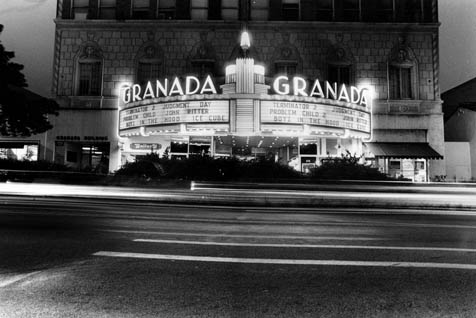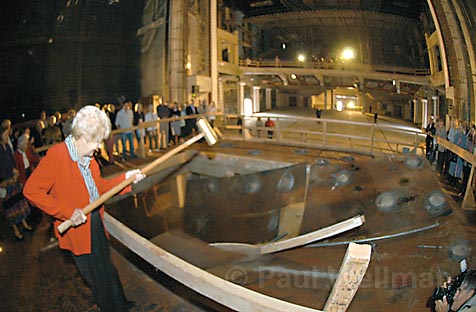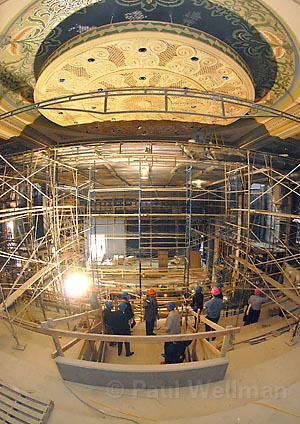The Granada Begins a New Century
100 Years of Excitement on State Street

The most anticipated renovation since the Parthenon is about to be unveiled in a marathon of special events. Beginning with a hard-hat-only sneak preview on Tuesday, March 4, a Spanish-themed patrons’ gala on Thursday, March 6, and Stephen Sondheim in conversation with Frank Rich on Saturday afternoon, the week will culminate in an all-day open house on Sunday, March 9, with between 5,000 and 15,000 people expected to pass through the theater.
When the curtain goes up for the first time since the film Cold Mountain closed there in March 2004, it will be a big day in the long story of this high-profile and at times controversial project, which goes by the name of the Santa Barbara Center for the Performing Arts, or more simply, the Granada. In the coming months, the new Granada will be tested in all the configurations for which it was planned, as top performers from pop, classical, jazz, theater, dance, and the spoken word will bask in the luxury of the building’s subterranean, state-of-the-art dressing rooms before taking an elevator to the enormous new stage.
There is so much to be excited about with this theater-the incredible talent lined up, the gorgeous, technically advanced restoration, even the gigantic hydraulic orchestra pit-that it remains slightly amazing to think that the real star of the Granada’s opening is the near-chaos of potential opportunities the new facility presents for the future. Whether you talk to skeptics or boosters, promoters who are already all in or those sitting out the first round, it’s apparent that nobody knows exactly how this grand experiment will ultimately turn out.
At eight stories high, the Granada building at 1216 State Street has always been oversized, at least for Santa Barbara. Virtually from the inception of this renovation project, it has been over-budget, officially totaling $52 million to date. And now, as the doors open to the public with 1,550 seats to be filled, it aspires to be over the top. Arguably the most important theater renovation in the country right now, the Granada is, according to Executive Director Peter Frisch, “certainly the most comprehensive, especially backstage.”
One of the area’s longest running question marks of the recent past now stands poised to become the center of the performing arts in Santa Barbara for the next hundred years. With an infrastructure built to handle the most drastic demands, the only question left is a simple, yet supremely interesting one: Which audiences and performers will come?

The O.G. (Original Granada)
The Granada was built in 1924 by C.M. Urton based on plans by architect A.B. Rosenthal, and, legend has it, a pile of do-it-yourself books on the unlikely topic of “how to make your own skyscraper.” Urton chose one of the early 20th century’s most popular theater names-there are Granada theaters all over the world, including a chain of them in England, and a big old rock palace in Dallas-and he did so even before the advent of Pearl Chase’s historic Hispanicization of Santa Barbara.
Opening night on April 9, 1924, was a vintage 1920s amalgam of film (Mademoiselle Midnight with Mae Murray), ballet, a 25-piece orchestra, and constant piping from a huge Wurlitzer organ. When the earthquake hit in 1925, the Granada suffered only minor damage, and the shows of all kinds went on. The theater was a favorite for out-of-town Hollywood premieres from the time of Gone with the Wind, and was still considered enough of an attraction in 1977 to earn the only regional 70mm print of Star Wars. In between movies at the O.G., all manner of acts appeared, and both the Santa Barbara Symphony and the Los Angeles Philharmonic (through the auspices of CAMA) became regulars.
Among the most fondly remembered eras, at least by theater fans, is 1984 to 2001, when the Granada was home to the Santa Barbara Civic Light Opera (CLO). This organization, which was founded by Paul Iannaccone and Elise Unruh, claimed a subscriber base of more than 12,000 and put on five fully staged musicals per year. The company morphed into the Music Theater of Santa Barbara before filing for bankruptcy in 2001, but in the seven years it operated, the CLO launched and advanced the careers of many of the area’s most respected actors, directors, and designers. It was at the end of the CLO era that Peter Frisch, the man at the helm today, first made his entrance.

Hammering Harriet
The Granada was not always everyone’s first choice for the location of the Santa Barbara Center for the Performing Arts (SBCPA). Beginning as early as the 1950s, there were plans floated to bring a new performing arts center to the city. As late as 2001, such important participants in the deal as Metropolitan Theatres owner Bruce Corwin were still concerned that renovating the Granada into a performing arts center would be a mistake, and that “a new facility would be better for everybody.”
But in 2003, Corwin and Granada building owner Rob Rossi relented and the deal that set the current project in motion was struck. No sooner were the millions donated by Michael Towbes and Sara Miller McCune deposited in the bank than there was former mayor Harriet Miller, now head of the SBCPA, swinging a sledgehammer at the wall that had blocked off the balcony since the place had been converted into a triplex movie theater.
Miller and her sledgehammer were to become a familiar sight during the next two years, as she was back again in 2005 when the time came to crush the old stage to make way for a much larger new one. Backers could be forgiven for thinking that Miller’s hammer was aimed straight at their bank accounts after a series of abrupt and costly revisions of the budget kicked in. Among the other timely financial saviors who joined the elite “over a million” club between 2004 and 2006 were Wendy McCaw and Leni Fe Bland.
As former mayor Miller continued to swing her mighty hammer, planners wondered aloud about the building’s exterior and its contribution to downtown’s aesthetics. In October 2004, Jonathan Maguire looked at the side fa§ade and saw “75 feet of bare concrete,” which made him wonder if “we’ve gotten ourselves into a situation where a large concrete box is historic.” Bendy White even once asked, “Is it ugly or not?”
Meanwhile, the ever-increasing cost became a sore point among competing arts organizations and the subject of an ongoing News-Press info box. But by 2005, the project’s real complications were still yet to come. UCSB’s Celesta Billeci had called it way back in 2001 when she remarked, “The negative to me is not knowing the timeline.” When the planned October 2006 opening date was pushed back until January 2007, the official culprit was an unexpected earthquake retrofit required by Rob Rossi in order to secure the upper seven stories. Little did presenters know that their promised spring 2007 season would soon be pushed back another full year. According to insiders, the delay cost Santa Barbara audiences the chance to see at least one new musical premiere, Love Sweet Love, a show based on the work of Burt Bacharach that ended up debuting in Thousand Oaks.
Built for 2108
Executive Director Peter Frisch’s voice rises only slightly when he talks about the Granada’s costs and delays. He doesn’t shy away from the subject, but does want the rationale to be clear, explaining, “The News-Press box [which detailed the cost increases in a graph] had the numbers right, but it neglected to report the decisions that were driving those numbers. The price of materials went up, but really what we were doing was making certain choices about how the theater : would function.”
Frisch explained that theaters across the country have renovated by putting “on another coat of paint,” but then had to cut performances and turn into dance clubs because they didn’t address the needs of contemporary theater. “We did not want to get caught in this trap,” said Frisch. “It’s the same rationale that drove the recent upgrading of the stage and proscenium at the Santa Barbara Bowl. An artist may want to play in your town, but if they can’t load their equipment into your facility, you can’t book the show. The idea from the beginning was to build something that would be able to handle the biggest shows out there, and to do that, we had to do things right. The choices we made that drove up the cost of the renovation were choices, not accidents, and they had to do with the idea that this place would last as a state-of-the-art venue for at least another hundred years.”
Former county arts commissioner Patrick Davis remains skeptical not only about what it cost to rebuild the theater, but perhaps even more so about what it will cost to run a live performance venue of that size year ’round. In a recent conversation, Davis said he was excited about the project, and that he wished the theater well, but that he saw the potential for an ongoing drain on the pocketbooks of Santa Barbara’s most generous philanthropists.
“It’s going to be a great hall, there’s no doubt about that,” Davis said, “but how soon can they fill it enough nights of the year to break even? Smaller regional organizations may not get much use out of a facility this size. It’s a great thing as far as the historic value of the building is concerned, but I am still haunted by the question: What if they built a theater and nobody came?” Davis doubts that revenues will be able to offset operating costs anytime soon, and estimates that big donors who have already sunk millions into the project could be on the hook for as much as $800,000 annually just to keep the building open.
Davis is not alone. Many smaller arts organizations feel left out because this is such a large hall, and few Santa Barbara-based companies have the subscribers to fill it. Frisch accepts that the programming mix will be tilted toward productions coming in from outside, even while he and others entertain dreams of large-scale productions that would originate here. In response to the question of whether or not the Santa Barbara Symphony, State Street Ballet, and Opera Santa Barbara can together keep the Granada afloat, Frisch said, “We are of course delighted to have the resident companies involved, and this is a community facility, but we will live and die over what we present [from outside]. The quality and diversity of what we program has to be absolutely first-rate. We can’t afford to be just any old performing arts center. The Granada must be special.”
To that end, the Granada has appointed a committee to oversee programming. These people will make policy that Frisch and his staff will implement. Although the Granada’s internal programming efforts will be substantial, it’s still not completely clear how the area’s established promoters will respond to the opportunity.
Five-Card Stud
With the world’s most advanced stage technology and a fabulous State Street location, what could possibly go wrong? Acoustics, for one thing. McKay Conant Hoover Inc. has been working with the SBCPA team since the beginning, and it has done everything to perfect the sound of the building. But until an orchestra plays the Granada in front of a live audience, there’s just no way to know.
Steven Cloud, who programs for both CAMA and the Lobero, considers the concert by the Los Angeles Philharmonic scheduled for Saturday, May 3, to be the acid test for the room’s acoustics. Dave Conant, the principal acoustician, feels confident that the acoustic bumps added to the walls and the oversized orchestra shell should offset any issues raised by the structure as a whole. But Conant is also aware that acoustical science is not perfect. In 2003, he told former News-Press arts writer Tom Jacobs that “people often ask me why the halls in Europe all sound so good, and I say, ‘Because the ones that sounded bad were torn down.'”

Though acoustic design begins with accommodating unamplified instruments, sooner or later there has to be a reckoning with the different demands of amplified music. For the Granada, that test will come on Friday, March 14, when soul singer Natalie Cole arrives for what’s being billed as the Granada Star Night. A co-production by Jacalyn Kane and the Granada, this will be the new venue’s first live pop music show, and may have more impact on the Granada’s future than any other early event.
Cole’s performance and the next pop show, the band America on Sunday, April 6, represent a surprising victory for the relative newcomer Kane, who’s been producing concerts all over the world for 20 years but only recently moved to Santa Barbara from Topanga. Concert promotion in Santa Barbara at this level has been, until now, a clubby affair, presided over by Moss Jacobs of the Nederlander organization, Billeci of UCSB Arts & Lectures, and Cloud, who now mostly books the Lobero. What these big established promoters have in common are iron-clad exclusive arrangements with specific venues. Nederlander books all the pop music shows at the Santa Barbara Bowl, for instance.
This is why the Granada’s policy for outside promoters-and Kane’s early involvement-is so interesting. For the first year, the Granada has capped the number of popular music shows a single outside producer can put on there at a total of five. The idea is to ward off so-called de facto exclusivity on the part of a single dominant force.
Frisch puts it even more bluntly, explaining, “We didn’t want anyone to be able to come in and tell the business side that they had a monopoly, so we limited it. There was a time when we might have gone another route, and considered a special relationship with Nederlander for the Bowl’s off-season, but in the end we thought it was not wise. We are community-dependent, and we thought we had to work with everybody.”
Asked about his decision to go with Kane’s two shows during the preview season, Frisch became animated, saying, “People have called her an outsider to me, but I just thought, look, she’s a human being. She’s a professional presenter and she presents a product that we like. I really believe that everybody needs an equal shot at this opportunity.”
Jacobs, Santa Barbara’s most established promoter, has toured the venue and was excited about it. But so far, Frisch said, “Nobody [from Nederlander]’s called.” Jacobs expressed enthusiasm for booking shows there in the future, saying that while he has “nothing specific” to announce at this time, he is “impressed by the quality of the renovation,” and thinks the Granada is going to be “an amazing live house for us.”
With Kane all in, much of the Granada preview season already set, and a busy Santa Barbara Bowl season coming up soon, audiences may have to wait until the fall to see what kind of acts Jacobs will bring to the space. In the meantime, the Granada’s first-year, five-slot cap on outside pop promoters creates a fascinating dynamic, something like a high-stakes poker game with only some cards on the table and a whole lot riding on the flop.
Broadway on State
In the meantime, two equally interesting and decidedly different events bear consideration. On Saturday, May 31, and Sunday, June 1, State Street Ballet and the Santa Barbara Choral Society will present Carl Orff’s Carmina Burana in a newly choreographed version by William Soleau. A full orchestra, 125 singers, and the entire ballet company will join forces to bring Orff’s titanic vision of the Middle Ages to life. In its sheer audacity, the production recalls the best of Santa Barbara’s “Primavera” heritage, and regardless of whether or not the ballet becomes one for the ages, it will be entertaining to see the members of the Choral Society decked out in monk’s robes and tonsured haircuts.
The second production is not due until the fall, but it could turn into one of the Granada’s most attractive dimensions. The 30-year-old Theatre League-based in Kansas City and run by veteran producer Mark Edelman-will present a full season of touring Broadway shows at the Granada, beginning on September 30, with Simply Ballroom starring Debbie Reynolds.
But while the Theatre League season is a fine one-also featuring Mamma Mia! and Footloose, among others-the intriguing part comes later. Within two years, Edelman plans to bring the mounting of a touring show to Santa Barbara. Whether this would be an original show remains to be seen, but what it means for our theater culture is clear: A show mounted at the Granada would be rehearsed here, the sets would be built here, the costumes would be designed and fitted here, and the $400,000 it typically costs to mount a show would be spent here. With this prospect comes a glimmer of what 2108 or even 2018 could be-a little bit of Broadway on State Street, and not a traveling one either, but a homegrown, big-time theater to rival the best in the world.
While Frisch asserted that Edelman is not the only producer with his eyes on this prize, he does admit that the concept pleases him. “Remember, for most of my career I have been a director,” said Frisch, “and there’s nothing that thrills me more than the idea that a new musical could originate here, with our community really affecting the process.”
So, until the next Rent pops up out of a storefront on Haley Street and catches the world’s attention from the new stage on the 1200 block of State Street, I’ll see you at the ballet : or the symphony, or the opera, or the rock concert, or the quiz show-and all at the new Granada.



